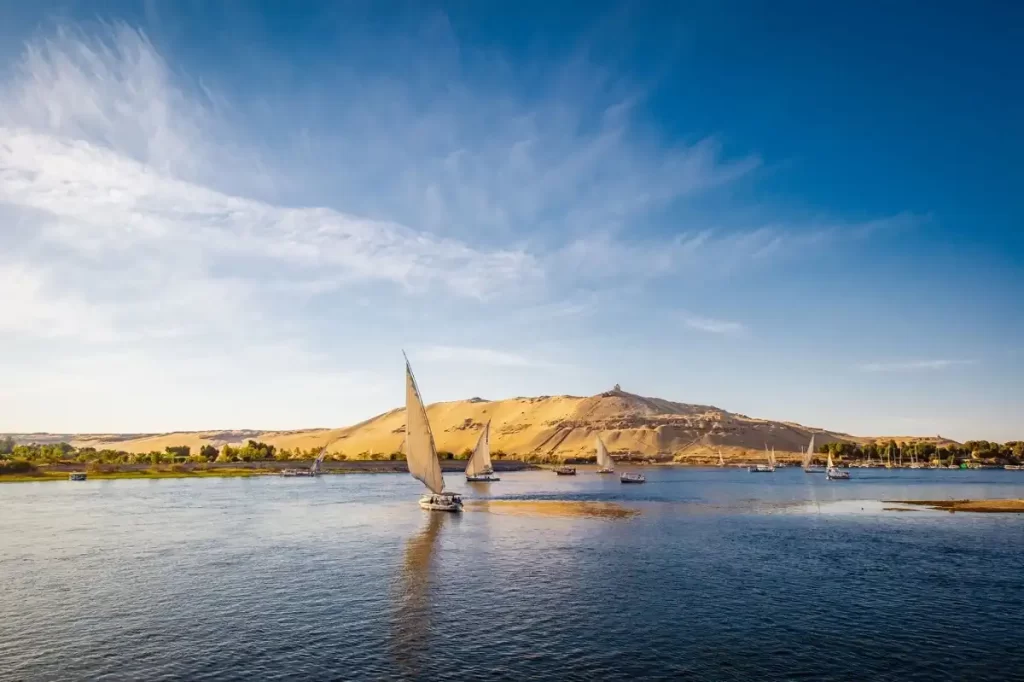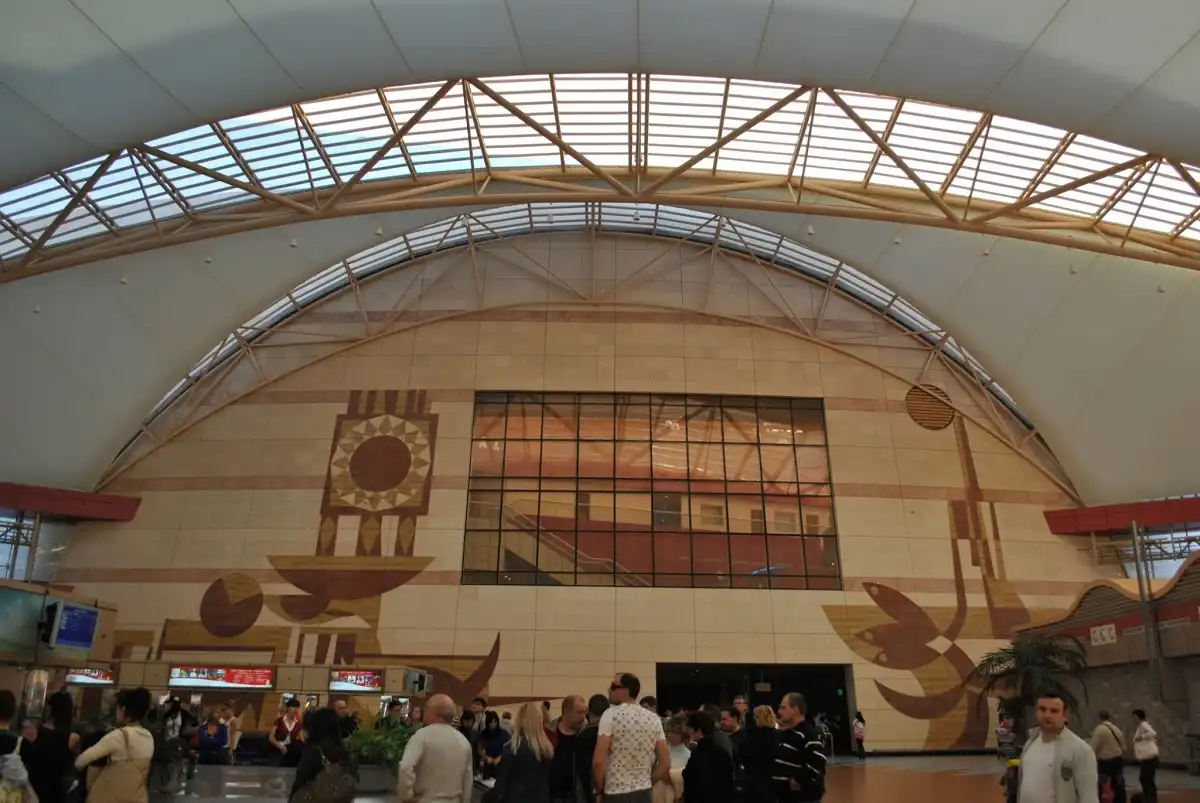
History of the Nile River
[ez-toc]
The Nile River “Bloodstream of Egypt” The Right and Full Information
Every soul in Egypt receives its life from the Nile River, which is a living marvel. This article’s goal is to provide every tourist with all the relevant information about the history, impact, and facts of the Nile River. A highly competent team of tour operators, tour guides, and researchers who are knowledgeable about the famous Nile River wrote this page. The Nile River has served as the primary source of irrigation for thousands of years, converting the arid region around it into fertile agricultural land. The River has been an essential source of irrigation and a corridor for trade and transit up to the present. The Nile River in Egypt symbolizes a tie that unites all families near the river’s edge and is surrounded by the remains of former civilizations.
Most people throughout the world have heard the old statement “Egypt is the Gift of the Nile” without giving it any thought or recognizing what it really means or how significant it is. The Nile River is the only natural landmark in the entire globe that has the power to captivate the mind. The Nile River is more than just a river; it also serves as a bridge connecting many different countries, from Lake Victoria to the Arabian Desert and the Nile delta, and a portal to the skies.
This essay will teach you everything you need to know about the Nile River in order to completely appreciate the meaning of this statement.
1-The Nile River Map and Where it is Located?
One of the longest rivers in the world, the Nile River originates in the rivers that flow into Lake Victoria, which is situated in present-day Uganda, Tanzania, and Kenya. It ultimately empties into the Mediterranean Sea more than 6,600 kilometers (4,100 miles) to the north. The Nile River is the world’s most important river since it connects the 11 African nations that make up the Nile Basin:
- Uganda
- Eritrea
- Rwanda
- The Democratic Republic of the Congo.
- Tanzania
- Burundi
- Kenya
- Ethiopia
- South Sudan.
- Sudan
- Egypt
The Nile River is the main water source in all these countries its water is pumped from two tributaries they are:-
- The White Nile
The major stream starts from the Great Lakes in Central Africa.
- The Blue Nile
The primary springhead of ninety percent of water.
Additionally, the two rivers’ confluence in northern Khartoum, the Sudanese capital, is surrounded by silt that comes from Ethiopia’s Lake Tana. Despite this, Lake Victoria, the largest lake in Africa, is still recognized as the Nile River’s primary source. The Nile River in Egypt runs from the northernmost point of Lake Nasser in Aswan to the north of Cairo, where it splits into the two branches that make up the Nile Delta: Damietta and Rosetta.
2-What is the Nile Delta?
One of the biggest river deltas on Earth, the Nile Delta is home to more than 40 million people who are divided into Branches.
The Nile in Egypt stretches from the northernmost point of Lake Nasser in Aswan to the northernmost point of Cairo, where it splits into two branches to form the Nile Delta:
The Damietta branch.
The Rosetta branch.
It is 161 km (100 miles) long from north to south and spreads out 150 miles (241 km) of the Egyptian coastline from Alexandria in the west to Port Said in the east.
3-The Historical Role of the Nile River
The Greek word “Nelios,” which means the river valley, is where the name “Nile” comes from. However, the term “black” was given to the Nile by the ancient Egyptians, who were referring to the rich, dark dirt that the river’s waters transported all the way from the Horn of Africa northward and dumped in Egypt as it flooded its banks every year in the late summer. The Nile Valley’s transformation into productive farmland due to the water and nutrient boom was the primary factor in the development of the Egyptian civilization in the middle of a desert. Ancient Egyptians classified their nation into two sections: Kemet, the “black land” of the Nile Valley, which provided life in the form of water and food for cities to flourish and grow, and Deshret, the “red land,” which was composed of the hot, arid desert.
Ancient Egyptians made their home along the banks of the Nile River, where they constructed small homes and cottages for lodging, produced a variety of crops, and domesticated various animals. From that point on, the foundations of Egypt’s legendary greatness were laid. As the Nile River flooded, bringing silt deposits that blanketed the nearby areas along the Nile Valley and rendered them fertile, cultivation was the first step. The first crop the ancient Egyptians raised was wheat, which they relied on the Nile floods to grow in order to combat the threat of starvation and a lack of food at the time. On the other hand, they used some animals, such as water buffalo, and camels, for transportation, plough work, and sustenance. In a nutshell, animals, crops, and people all depend on the Nile River. The majority of Egyptians eventually relocated to the Nile Valley in order to access food. As the ancestors gathered on the banks of the Nile, they gave birth to the heavenly ancient Egyptian civilization, one of the greatest civilizations in the history of mankind, which saw the construction of numerous temples and tombs filled with priceless artifacts and jewelry. The Nile River’s influence also stretches to Sudan, where it greatly aided the ascent of the Sudanese kingdoms.
4-The Nile River Religious Facts
The Nile River was honored by the creation of Sobek, the “Deity of the Nile,” or “Deity of Crocodile,” by the ancient pharaohs as part of their interest in religion and their insistence on creating many gods and goddesses from natural elements. Sobek represented fertility, wetlands, medicine, and sudden death, and the Nile River is thought to be his sweat. “Hapy,” also referred to as “Lord of the River Bringing Vegetation” or “Lord of the Fish and Birds of the Marshes,” is another deity associated with the Nile in Ancient Egyptian mythology. He was the deity of the annual floods of the Nile, which significantly controlled the water level and symbolized fertility. The quantity of silt that overflowed the river banks each year was thought to be under the power of the water deity “Khnum,” who ruled over all types of water like lakes and rivers in the underworld. Rich silt was transported by the overflows to the Nile Valley’s plains so that crops could be grown there. For both ancient and modern Egyptians, the Nile River functioned as a hub of creativity and daily life. The Nile was acknowledged as the source of all life and was known as the father of all men. The Nile was referred to by the ancient Egyptians as “p” or “Iteru,” which means “River” in the ancient Egyptian language. The word “Black” (Ar or Aur) also refers to the black silt that is left over from the yearly flooding. The Latin term “Nilus” and the Greek word “Neilos,” which means valley, were combined to form the name “Nile.” The Nile is now referred to as “Al-Nil, Al-Bar, Nahr Al-Nil, or Bar Al-Nil” throughout Egypt and Sudan. One of the most spiritual experiences on earth, the Nile River Cruise is regarded as the best way to see all the beauty, significance, and facets of the divine Nile River.
5-The Flooding of the Nile
The community has patiently awaited floods every year since ancient times. The Nile had a significant impact on ancient Egyptian culture because it divided the year into three seasons, each of which had four months: “Akhet” denoted the flood season when the Nile overflowed, “Peret” denoted the growing season when the soil was fertile due to the Nile’s silt, and “Shemu” denoted the harvest season during dry periods. In the contemporary era, Egypt tried to regulate the Aswan High Dam in order to have better control over the flooding of the Nile, similar to how the Aswan High Dam in 1970 had a significant improvement over the irrigation systems and a beneficial overall rise in agriculture throughout Egypt.
6-The Wildlife of the Nile
The Nile River is rich in wildlife, including the African tiger fish, known as the “Piranha of Africa,” Nile monitors, rhinoceroses, giant Vundu catfish, tortoises, wildebeests, baboons, hippopotamuses, frogs, turtles, mongooses, and more than 300 different species of birds. The Nile is famous for the Nile crocodile, which stays outside of the upper Nile basin.
7-The Nile River History, plus its Agricultural and Economic Role
The Nile River served as the best historical record of the ancient Egyptian civilization and holds the key to success in many other spheres. The ancient Egyptians had a crucial transportation route in the Nile River, which enabled them to develop into expert watercraft and shipbuilders. The Old Kingdom, which lasted from 2686 to 2181 B.C., is depicted in art as having boats that moved wood, vegetables, fish, livestock, and other cargo. Ancient Egyptians placed such a high value on boats that they used them to bury deceased monarchs and officials, including King Khufu’s sun boat. The construction of the Great Pyramid is documented in an ancient papyrus diary of a government official who resided in the old kingdom. It explains how laborers brought large blocks of limestone on wooden boats along the Nile through a canal system to the pyramid.
The Egyptian empire’s first endeavor, and one of its pillars, was cultivation. When the Nile River overflowed, the water level rose, transporting the rich silt deposits and flooding the valley’s farms, increasing their fertility. The flood season was used by the ancient Egyptians to raise crops for food. They relied on a few domesticated animals to assist them in their daily agricultural labor. These creatures had made the Nile River their permanent home, where they could always find the Nile waters. On the other hand, the Nile served as the principal route for travelers and cargo between Cairo and the rest of Africa, particularly between the nations of the Nile Basin. In the past, people traded products and cargo along the Nile using crude wooden canoes. Economic development brought on by these exchanges raised the Nile River’s status and fame.
8-Recommended to Experience Nile River Cruise
As was previously noted, the ancient Egyptians built their civilization upon the banks of the Nile River. As a result, the majority of Egypt’s historic sites are located along the Nile, particularly in Upper Egypt. As a result, Egyptian travel firms and vacation organizers frequently incorporate the Nile into their Egypt tour packages in and around Luxor and Aswan by taking advantage of its extraordinary geographic accessibility, outstanding historical attraction along its banks, and close vicinity.



